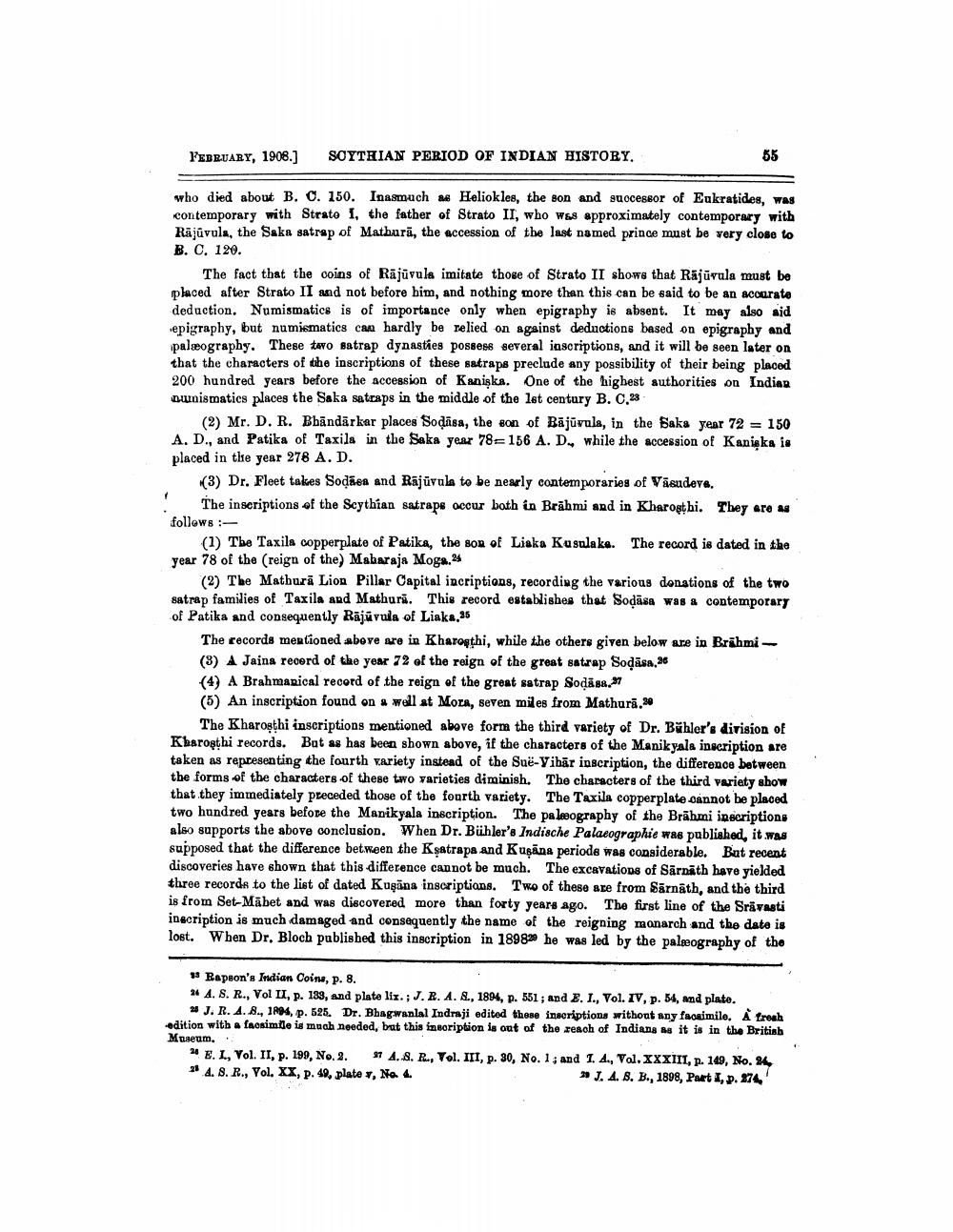________________
FEBRUARY, 1908.]
who died about B. C. 150. contemporary with Strato I, Rājūvula, the Saka satrap of B. C. 120.
SOYTHIAN PERIOD OF INDIAN HISTORY.
55
Inasmuch as Heliokles, the son and successor of Eukratides, was the father of Strato II, who was approximately contemporary with Mathura, the accession of the last named prince must be very close to
The fact that the coins of Rajuvula imitate those of Strato II shows that Rajuvula must be placed after Strato II and not before him, and nothing more than this can be said to be an accurate deduction. Numismatics is of importance only when epigraphy is absent. It may also aid epigraphy, but numismatics can hardly be relied on against deductions based on epigraphy and paleography. These two satrap dynasties possess several inscriptions, and it will be seen later on that the characters of the inscriptions of these satraps preclude any possibility of their being placed 200 hundred years before the accession of Kaniska. One of the highest authorities on Indian numismatics places the Saka satraps in the middle of the let century B. C.23
(2) Mr. D. R. Bhandarkar places Soḍāsa, the son of Bajuvula, in the Saka year 72 = 150 A. D., and Patika of Taxila in the Saka year 78=156 A. D., while the accession of Kaniska is placed in the year 278 A. D.
(3) Dr. Fleet takes Soḍāsa and Rājūvula to be nearly contemporaries of Vasudeve.
The inscriptions of the Scythian satraps occur both in Brahmi and in Kharosṭhi. They are as follows:
(1) The Taxila copperplate of Patika, the son of Liaka Kusulake. The record is dated in the year 78 of the (reign of the) Maharaja Moga.2
(2) The Mathura Lion Pillar Capital incriptions, recording the various donations of the two satrap families of Taxila and Mathura. This record establishes that Sodasa was a contemporary of Patika and consequently Rajuvula of Liaka,25
The records mentioned above are in Kharosthi, while the others given below are in Brahmi(3) A Jaina record of the year 72 of the reign of the great satrap Soḍāsa, 28
(4) A Brahmanical record of the reign of the great satrap Soḍāsa,37
(5) An inscription found on a well at Mora, seven miles from Mathura.20
The Kharosthi inscriptions mentioned above form the third variety of Dr. Bühler's division of Kharosthi records. But as has been shown above, if the characters of the Manikyala inscription are taken as representing the fourth variety instead of the Sue-Vihar inscription, the difference between the forms of the characters of these two varieties diminish. The characters of the third variety show that they immediately preceded those of the fourth variety. The Taxila copperplate cannot be placed two hundred years before the Manikyala inscription. The paleography of the Brahmi inscriptions also supports the above conclusion. When Dr. Bühler's Indische Palaeographie was published, it was supposed that the difference between the Ksatrapa and Kusana periods was considerable. But recent discoveries have shown that this difference cannot be much. The excavations of Sarnath have yielded three records to the list of dated Kugana inscriptions. Two of these are from Sarnath, and the third is from Set-Mabet and was discovered more than forty years ago. The first line of the Srävasti inscription is much damaged and consequently the name of the reigning monarch and the date is lost. When Dr. Bloch published this inscription in 189829 he was led by the paleography of the
13 Rapson's Indian Coins, p. 8.
24 A. S. R., Vol II, p. 133, and plate lix.; J. R. A. S., 1894, p. 551; and E. I., Vol. IV, p. 54, and plate.
25 J. R. A. 8., 1894, p. 525. Dr. Bhagwanlal Indraji edited these inscriptions without any facsimile. A fresh edition with a facsimile is much needed, but this insoription is out of the reach of Indians as it is in the British Museum.
20 E. L, Vol. II, p. 199, No. 2. 37 A..S. R., Vol. III, p. 30, No. 1; and 1. A., Vol. XXXIII, p. 149, No. 24 24. S. R., Vol. XX, p. 49, plate v, No. 4. 2 J. A. 8. B., 1898, Part I, p. 274,




